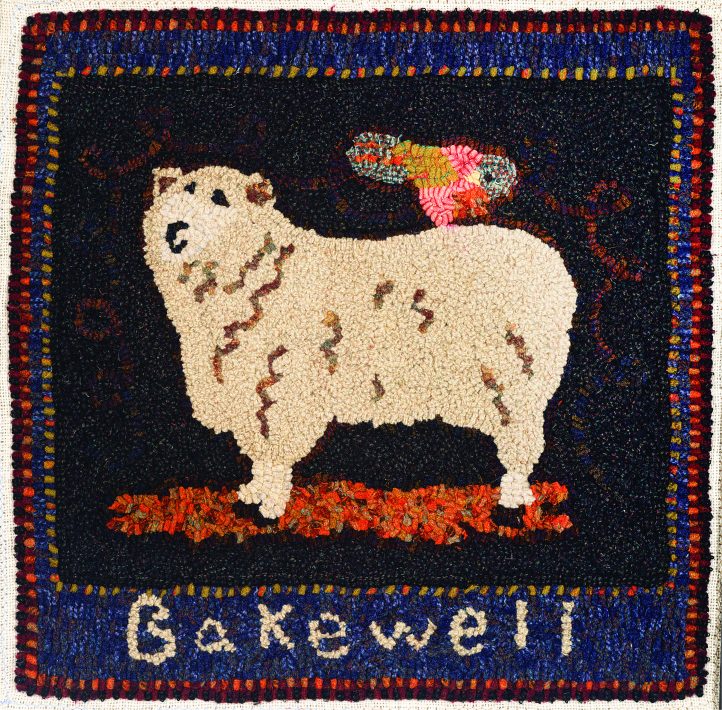
Katherine Lotz’s primitive style shines in her two rugs. Bakewell, designed by Trisha Burberry, is 18″ x 18″.
The marketplace, the workshops, and the classes were humming with activity. People scurried back and forth, meeting old friends, making the last purchase of the day, making plans to meet for supper. The rug exhibit was filled with people carefully studying the rugs on display, comparing notes and comments with their friends and companions.
Most attendees were not particularly young; one could even say they were on the “mature” side. However, every so often, a young person would walk by, appearing to be just as serious a rug hooker as those who were obviously decades older. These “youngsters” caught our eyes and made us smile. Here comes the future of rug hooking!
Crafters in many different fields are noticing a revival of sorts in handcrafts of all types. Rug hooking is no exception. And a large part of any revival must be the introduction of young men and women into the art. An art or craft will only thrive if new participants learn and pass it along.
Here are three of the next generation of rug hookers who made themselves heard at the 2009 ATHA Biennial in Louisville, Kentucky. Talking with them, we see what drew them to our craft and what appeals to them as young people. We also look back to revisit and pay tribute to a few other, more experienced, voices who are now mentoring the young. Once young hookers themselves, we look to see what they are doing with the craft years later.
THE YOUNG PEOPLE
Katherine Lotz

Katherine Lotz’s primitive style shines in her two rugs.
Since the age of eight, Katherine has made jewelry, cross-stitched, and knitted, sharing many of her mother’s interests. At fifteen, Katherine Lotz took a rug hooking workshop at the Shaker Village with her mother. Experimenting with a new craft was right up their alley. Katherine recalls being stunned by the incredible beauty of the rugs and thrilled with how relaxed she felt hooking. With the help of Trish Burberry, her teacher, she color planned a second project in the primitive style just months later. In the past two years, Katherine has completed several projects.
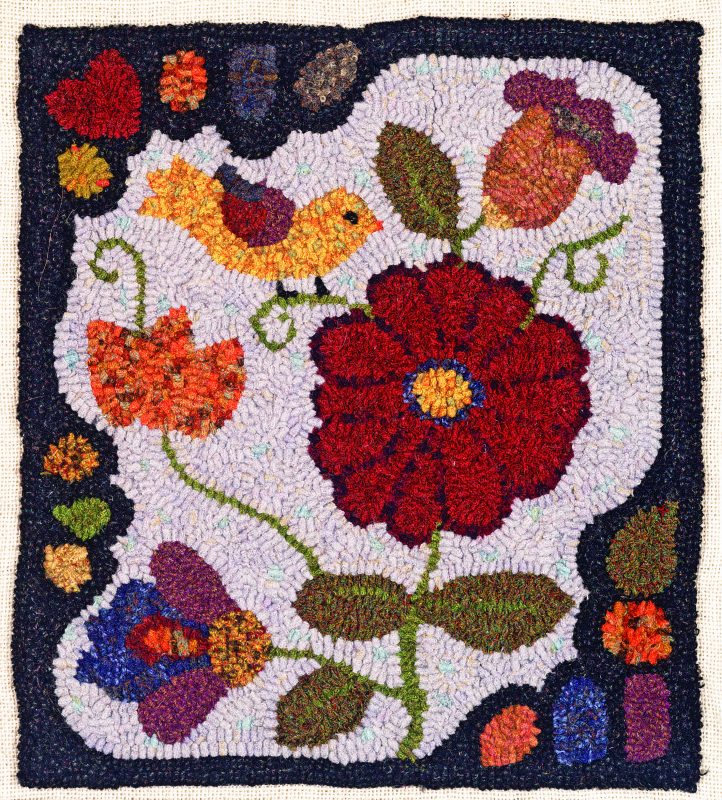
Katherine Lotz’s primitive style shines in her two rugs. Anne’s Garden, designed by Holly Hills Design, is 13″ X 15″. IMPACT XPOZURES
Katherine plans to design and plan her own pieces one day. Working on patterns has given her confidence in technique and color planning. She especially enjoys color planning with her teacher and looks forward to more experimenting.
One day, Katherine would like to teach beginners how to rug hook, inspiring them to be creative and appreciate their own fresh ideas. “I hope when that happens I can reach out to others as so many rug hookers I have encountered have reached out to me.”
Beth Schroering
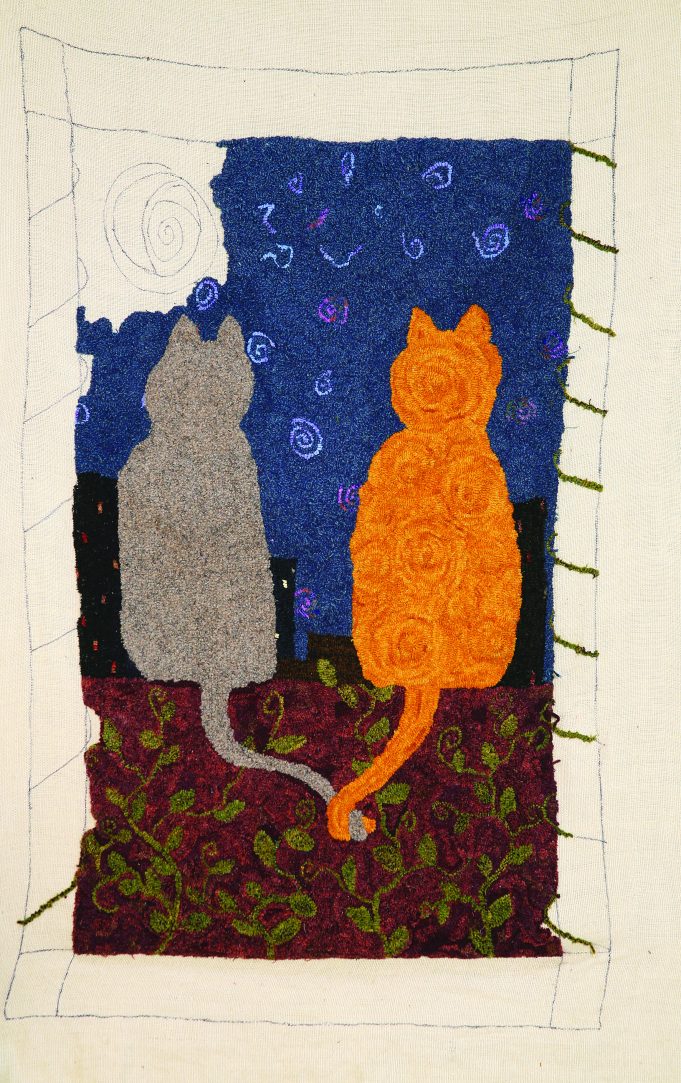
Beth Schroering’s work in progress features her own design of two cats staring at a starry sky. Each seems to be contemplating the universe alone, but their linked tails give them away. 44″ x 28″. BETH SCHROERING
Several years ago, while attending the Indiana State Fair with 4-H, Beth heard the sound of dulcimers from the American Heritage area of the fair. Drawn to the music, she and her father wandered over to enjoy the concert, and then they walked through several different exhibits, coming across one that displayed hooked rugs. Beth was immediately intrigued by the simple technique that led to such stunning rugs.
Filled with questions, Beth talked with the demonstrators. When she got home, she wasn’t able to find a local group to hook with, so she put the idea on hold for more than four years. That’s when the Carnegie Center for Art and History in New Albany, Indiana, offered a rug hooking class. Beth and her brother enrolled in the workshop and were amused to find themselves the youngest in the group—by far. After learning the skill of loop pulling with a hit-or-miss coaster project, Beth and her brother immediately purchased hoops and hooks and have both worked on projects since.
“I am in the infant stages of being a true rug hooker,” Beth says, “but I am already trying new styles and patterns. I would like to explore fine shading, to make objects and landscapes look as realistic as possible.
“I have found an art form that is not only durable and beautiful, but also capable of diverse styles. I hope that with young people starting to take an interest in this art form, it will not be long before teens will become regulars at shops and events around the country.”
Lauren Lullo
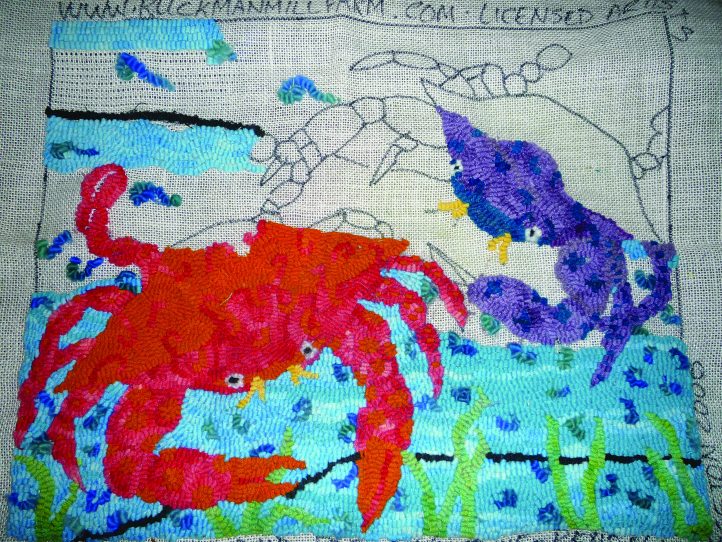
Brilliant colors highlight crabs in a work in progress, design by Ruckman Mill Farm. LAUREN LULLO
Lauren Lullo had only been hooking two months when she attended the ATHA conference with her mother. Interested in folk art, they traveled to the Sauder Village Rug Exhibit in Archbold, Ohio in August. There they were excited by the hooked rugs and were motivated to learn more, so they enrolled in a beginner’s course conducted by Nancy Blair. They took the Gallery Walk through the hundreds of inspiring rugs with Susan Feller.
Since then, Lauren completed a beginning project, and they both enrolled in other workshops, including Kim Dubay’s Artist Trading Card class. Lauren found the smaller ATCs less intimidating than the larger projects and she considers them a good way to work out an idea in miniature first. By December, she had completed the Prodded Sheep pattern from Gail Dufresne.
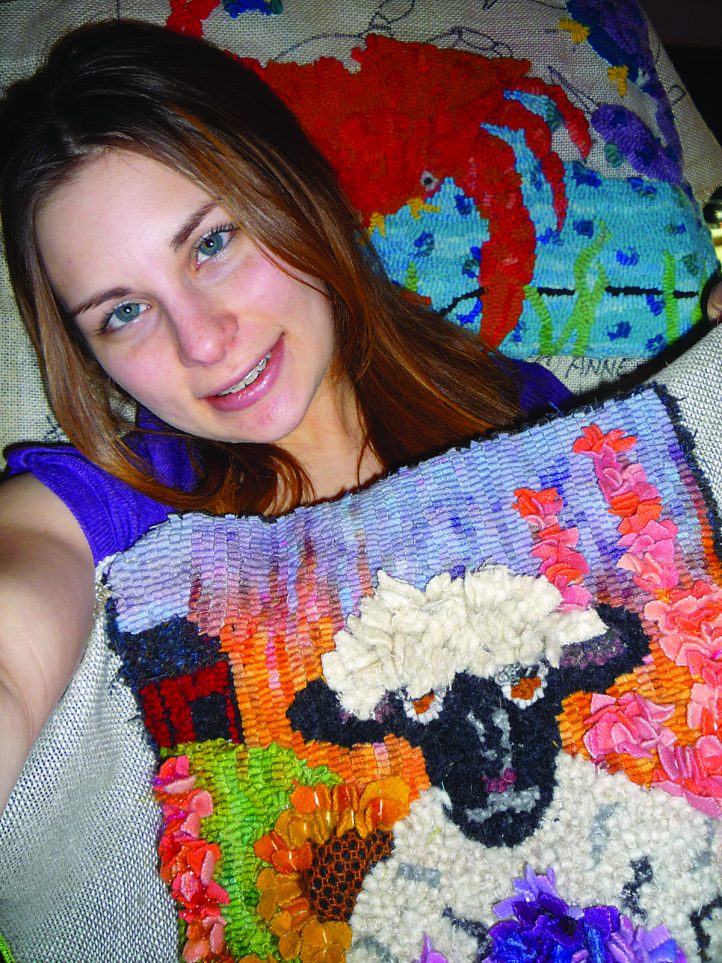
Lauren shows off her prodded sheep pillow, 12″ x 12″, designed by Gail Dufresne.
Lauren weaves her painting interests into rug hooking. The pattern on her frame now is Maryland Friends by stained glass artist Anne-Renee Livingston, available through Ruckman Mill Farm. Time seems to fly as she hooks. “It’s fun hooking . . . I’m oblivious to the time,” she says. “Hours feel like minutes. Now that I understand all the work involved in making a hooked rug, including the color planning, I love to sit down and enjoy it all.”
As she masters more skills, Lauren is even more attached to rug hooking as an art form, recognizing the potential the medium provides to interpert any visual concept. She is excited to spend time creating such satisfying art and has set a goal to work on a monochromatic scheme. “I learn something new every day with hooking,” she says. “I’m glad I was introduced to it.”
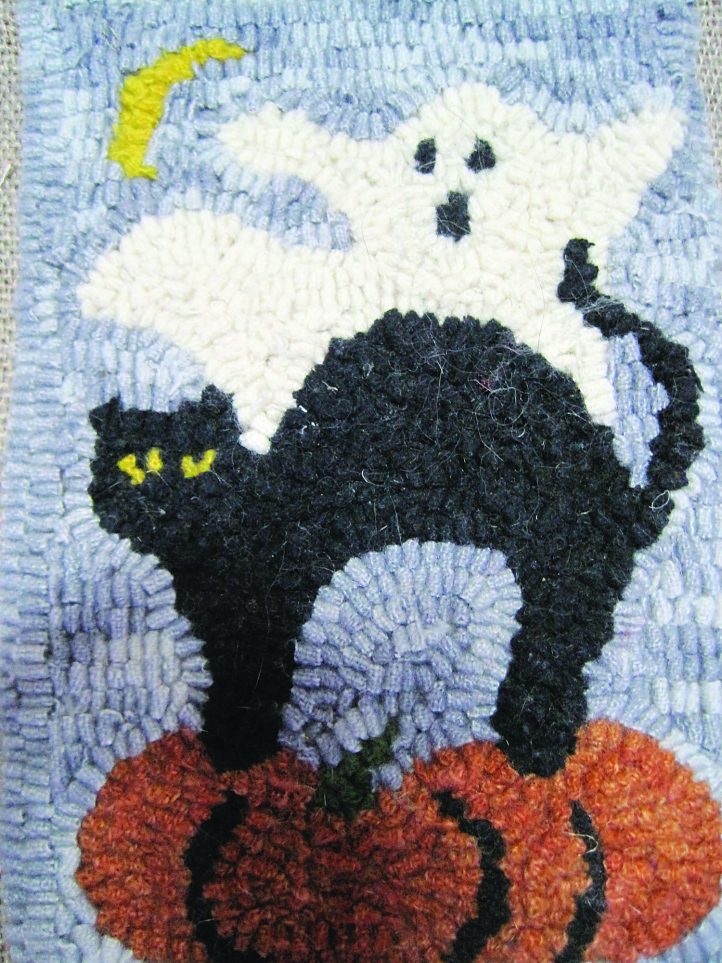
Muted colors enhance her 8″ x 6″ Trick or Treat Halloween rug. LAUREN LULLO
YESTERDAY’S YOUNG PEOPLE
Jasmine Benjamin
Mothers and their daughters often develop an interest in and a love of rug hooking together. Jeanne Benjamin of New Earth Designs in Massachusetts and her daughter Jasmine travel together to rug camps throughout the United States. Usually, Jeanne is teaching and Jasmine enrolls in another instructor’s workshop. Jasmine is in her early thirties now; Jeanne taught her to hook when she was seven. Jasmine is a busy bank manager, but her rug hooking centers her and keeps her and her mother close.
Tanya Azzaro
Tanya was eight when she learned to hook. Her parents Steve and Marie own Yankee Peddler, a long-standing rug hooking supply source in Killingworth, Connecticut. Now in her mid-thirties, Tanya is an occupational therapist, makes soap, continues to design and hook. She fills commissions and sells work through a shop in Connecticut. “She is up to something all the time,” says Marie. Tanya mixed music and rug hooking, both talents of her parents, as her interests. She took to dyeing and many clients still remember her for her colors.
Andrea Sheppard
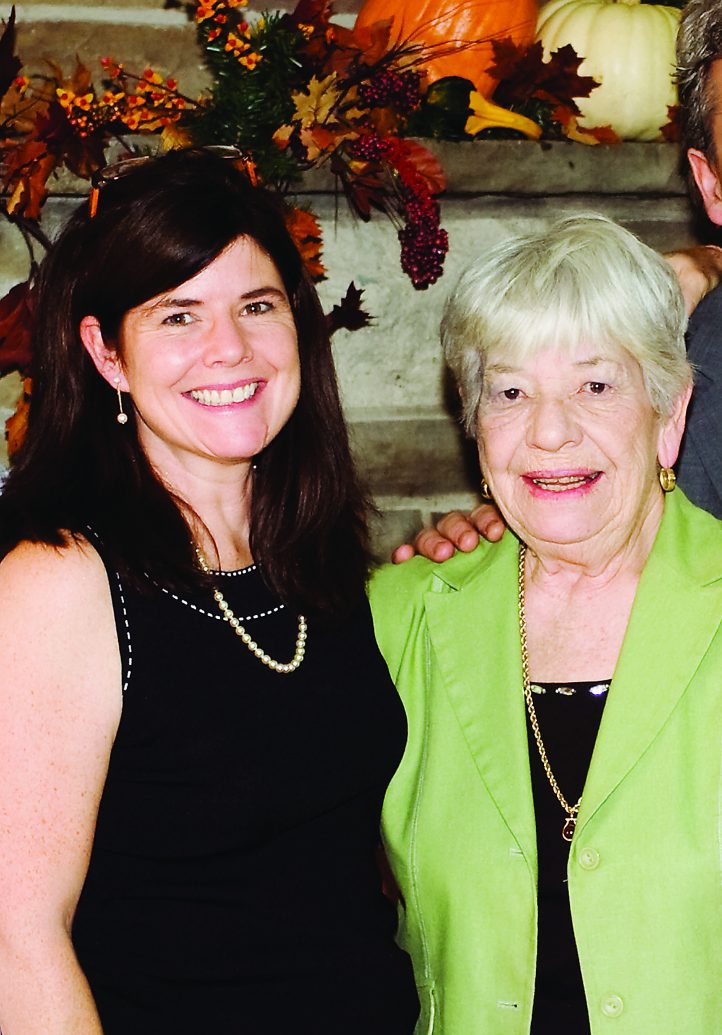
Andrea Sheppard and her mother and rug hooking teacher, Jeanne Field. ANDREA SHEPPARD
Andrea, from Ritter Mere-Hurst-Field, Aurora, Ontario, is involved in the business with her mother business Jeanne Field. As the youngest of several siblings, she often traveled with her mother to rug camps and events. Her early memories of rug hooking include the discipline of making four kits before any friends could come over to play. With none of her friends interested in crafty things during her teens, Andrea fell away from rug hooking. But in her early thirties, she entered the business with Jeanne and joined the Ontario Hooking Craft Guild, and she began on her own path in rug hooking.
Andrea recalls, “It is the people that keep me involved in rug hooking. I have a young family and the business to run so my actual hooking time is very limited. But the people who I see in the studio, at shows, and in the Georgetown Rug Hooking Guild keep me involved, challenged and inspired.”
Stephanie Ashworth-Krauss
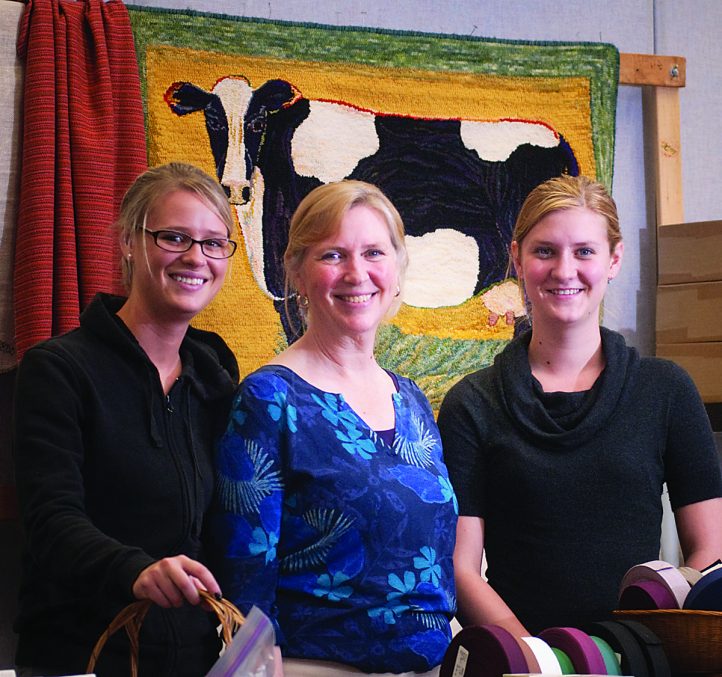
Stephanie Ashworth-Krauss (center) learned rug hooking from her mother, Anne Ashworth, and then passed her knowledge of the craft on to her three daughters, Lindsay, Mariah, and Cecely (not pictured). ROBERT EDDY
Stephanie Ashworth-Krauss of Green Mountain Hooked Rugs in Montpelier, Vermont, and her daughters, Cecely, Lindsay, and Mariah, had the experience of a generational rug hooking instructor too: Anne Ashworth. Anne taught her daughter Stephanie the basics of hooking when she was only six. By her teens, Stephanie had learned to dye wool from Anne, a master dyer who had developed Green Mountain Colors recipes and coauthored several dye books.
In her early twenties, Stephanie turned to rug restoration to supplement her family income. But not until she was almost thirty did she feel rug hooking was her own choice.
Stephanie’s own girls have each taken to their heritage in their own way. Cecely learned rug hooking around age ten. Working in the shop during her twenties helped her to learn design principles. Lindsay studied business and regularly works at the Rug School with the family. Mariah learned to hook when she was six and continued into high school. In college, knitting was the rage, but whenever she returned to Vermont, the dyeing and designing aspects of rug hooking drew her back. She has a remarkable eye for composition and color and also works at the Rug School with her sister and mother.
REACHING OUT TO YOUNG PEOPLE
- When demonstrating, have appealing handouts available. List local and regional groups. Encourage handouts young family members to demonstrate with your groups.
- Include a youth category when putting on a show. Exhibits are great places to meet people and ask questions.
- Hands on experience at any age is the best entry into any craft. Invite one of your young family members along to an exhibit or workshop fun. Making a rug for a grandchild is fun, but taking a grandchild to a camp or show is even better.
- Girl Scouts of America: The Brownies and Juniors both a have badges and applicable to rug hooking and other fiber arts. As a guild or individual, volunteer to teach rug hooking to your local troop.
